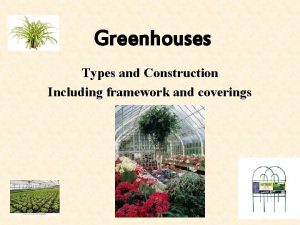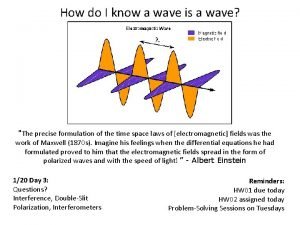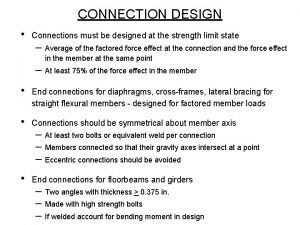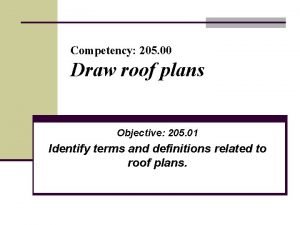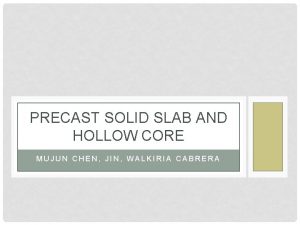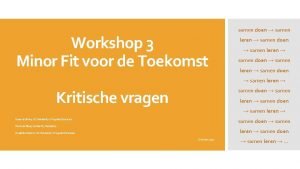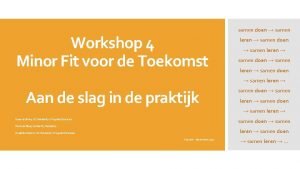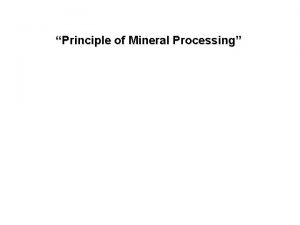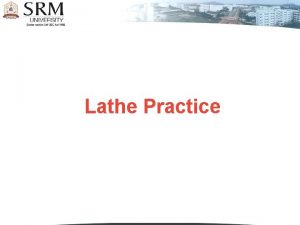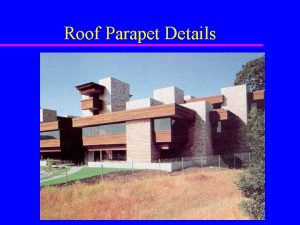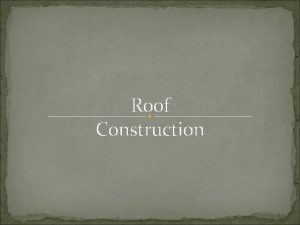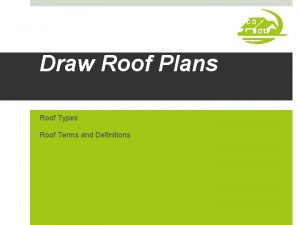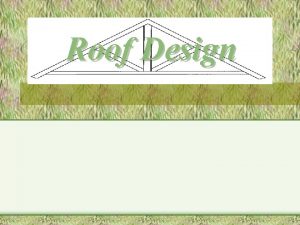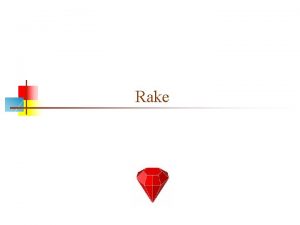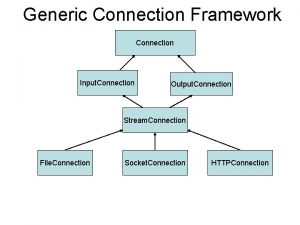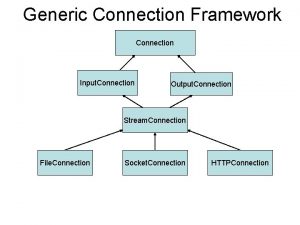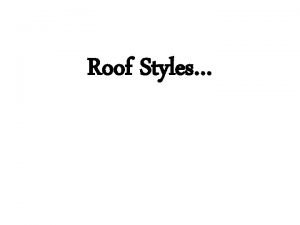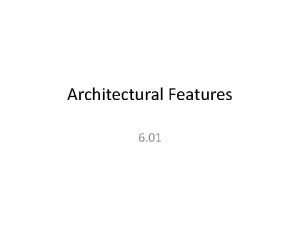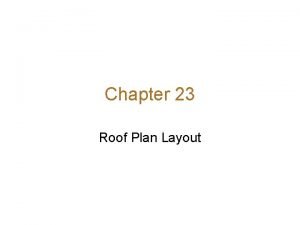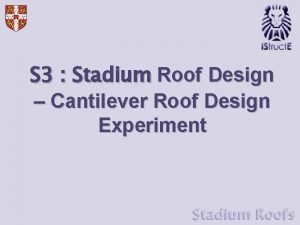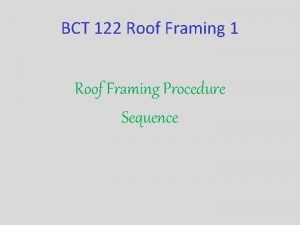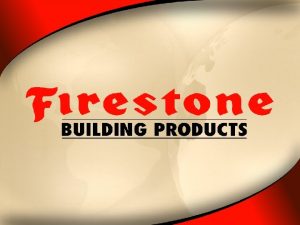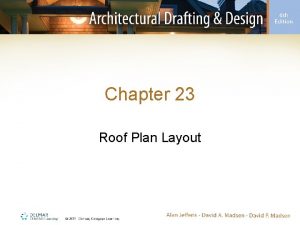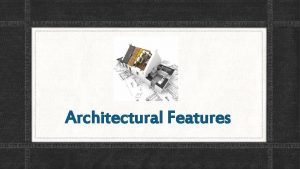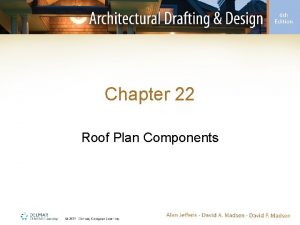Roof Connection Details Eave Rake Details u Definition





















- Slides: 21

Roof Connection Details

Eave & Rake Details u. Definition: Architectural details that incorporates the roof to the wall assembly u Common members included in details: – fascia and fascia trim – soffit and soffit vents – lookout or outrigger – slope/pitch – rafter and ceiling joist – double top plate

Terms to Know--Rake Detail u Definition: Detail taken at the sloped edge of roof or at the gable end of the building, usually this detail is perpendicular to Eave Details

Terms to Know--Fascia u Finished member secured to end of rafters u Some construction include a sub-fascia in preparation to receiving a finished fascia.

Terms to Know--Soffit u Enclosed/boxed-in area or open area below rafters on the overhang of a roof Soffit Area

Terms to Know--Eave Detail u The projecting portion of the roof parallel to the slope. Sometimes called the cornice detail u To draw eave detail, architect needs to know – roof material--wood vs. composition shingles – rafter size & spacing – roof/eave overhang – roof slope/pitch – roof sheathing – exterior wall sheathing – eave design Eave Detail

Roof Pitch u Pitch – Rise over Span – Always reduced to the smallest fraction

Roof Slope u Slope – Slope is stated as a ratio of rise over run with run, run is 1/2 of span but is always expressed as a base of 12 – Slope is placed on a detail as a upside down triangle with 12 (run) horizontal line and rise by the vertical line

Drafting Slope in a Detail the slope is 6: 12 as shown below u All is necessary is to determine hypotenuse of a triangle having a base of 12 units and the leg of 6 units u Draft a line 12” long using the scale of your drawing u Then a vertical line 6” long with the same scale u The diagonal is the slope for this problem r o f E G N I IL A ET D IN L E P O L S 12” BASE LINE 6” LEG LINE u Assume

Calculations for Slope u Problem: Span of a building is 30’, Rise is 5’, what is the slope? u Run = 1/2 Span =. 5 x 30 = 15 u Slope = Rise/Run = 5/15 = x/12 (Convert) 15 x = 5 x 12 u x(new rise) = (5 x 12)/15 u x(new rise) = 4 SLOPE = 4: 12

Eave Designs

1) Exposed Tail Rafters u An exposed wood member that is spliced to the common rafters u Usually thicker than common rafter with the spacing further apart

Boxed Cornice--Soffit Styles u 1) Boxed Horizontal u 2) Boxed Parallel to rafter, sloped u 3) Either styles can be Open or Enclosed

2) Boxed (Enclosed) verses Open Soffit u Boxed Horizontal or Boxed Parallel to rafter and sloped Boxed Horizontal Soffit Open Soffit Slopped Open Soffit

Soffit Design Considerations u 1) Must make provision for ventilation – eave soffit (intake) and attic (exhaust) u 2) Determine area of ventilation – Attic area (x) 1/150 = total area of ventilation req’d (net free area) u 3) Determine location of ventilation – eaves-- soffit contiuous vs. soffit cutout – gable ends--square, rectangle, round or triangle shape – ridge --continuous along roof ridge – roof --various types projecting out of the roof

Ventilation Products/Suppliers Ventilation Types: 1) Roof Louvers 2) Gable Louvers 3) Ridgeline Vents 4) Gravity Turbines 5) Power Vents

3) Fascia Styles and Designs u vertical vs perpendicular Fascia perpendicular to rafter Fascia vertical to rafter

Drafting the Eave Detail u It is recommended to complete the eave detail design before drafting other roof details u Common eave/cornice detail scale sizes:

Rake Detail u Rake - assembly along sloping edge of roof u Usually different overhang from eave u No need to “notch” for rafters

Detail Example Eave Detail Notes Scale: 1 1/2” = 1’-0” u u u u 5 -Ply built-up roof w/ 50# building felt@ edge 3/4” CDX plywood 5/8” GB (Interior finish) 38 R fiberglass batt insulation(12”)(ceiling) 2 x 8 CLG Joist @24”OC Pre-fab trusses optional 1 x 6 T&G siding over 1/2” OSB 15# felt between (Match previous details) Add 1 x 3 trim at fascia Full fiberglass batt insulation in wall

Detail Notes Continued Scale: 1 1/2” = 1’-0” u Attic insulation R 38 - 12” foil faced fiberglass batt u 2 x 8 rafter and ceiling joist @ 24” OC (or prefab wd truss) u 1/2” AC exterior plywood soffit u 7/8” stucco exterior finish w/ 1 x 2 redwood ground at top next to soffit u 24” overhang (from stucco to fascia) u 2 x 4 lookout @ 24” OC u R 11 -3 1/2” craft faced fiberglass batt in (2 x 4 studs @ 16” OC
 Positive rake vs negative rake
Positive rake vs negative rake Gothic arch greenhouse pros and cons
Gothic arch greenhouse pros and cons Wave after eave
Wave after eave Design of steel truss
Design of steel truss Slip critical connection vs bearing connection
Slip critical connection vs bearing connection A325sc bolt
A325sc bolt Slip critical connection vs bearing connection
Slip critical connection vs bearing connection Text to world connections examples
Text to world connections examples Flat roof plan example
Flat roof plan example Types of roof plans
Types of roof plans Hollow core slab connection details
Hollow core slab connection details Open-web steel joist connection details
Open-web steel joist connection details What is rake angle in dentistry
What is rake angle in dentistry Fictional character
Fictional character 245 bur uses
245 bur uses Rake vragen workshop
Rake vragen workshop Uml activity diagram tutorial
Uml activity diagram tutorial Rake vragen workshop
Rake vragen workshop Rake classifier working principle
Rake classifier working principle Introduction to lathe machine
Introduction to lathe machine A wrangler and buffoon
A wrangler and buffoon Parapet wall material
Parapet wall material

